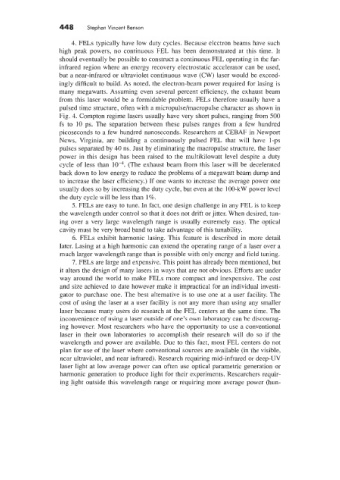Page 488 - Tunable Lasers Handbook
P. 488
448 Stephen Vincent Benson
4. FELs typically have low duty cycles. Because electron beams have such
high peak powers, no continuous FEL has been demonstrated at this time. It
should eventually be possible to construct a continuous FEL operating in the far-
infrared region where an energy recovery electrostatic accelerator can be used,
but a near-infrared or ultraviolet continuous wave (CW) laser would be exceed-
ingly difficult to build. As noted, the electron-beam power required for lasing is
many megawatts. Assuming even several percent efficiency. the exhaust beam
from this laser would be a formidable problem. FELs therefore usually have a
pulsed time structure, often with a micropulse/macropulse character as shown in
Fig. 4. Compton regime lasers usually have very short pulses, ranging from 500
fs to 10 ps. The separation between these pulses ranges from a few hundred
picoseconds to a few hundred nanoseconds. Researchers at CEBAF in Newport
News, Virginia, are building a continuously pulsed FEL that will have 1-ps
pulses separated by 40 ns. Just by eliminating the macropulse structure, the laser
power in this design has been raised to the multikilowatt level despite a duty
cycle of less than lo4. (The exhaust beam from this laser will be decelerated
back down to low energy to reduce the problems of a megawatt beam dump and
to increase the laser efficiency.) If one wants to increase the average power one
usually does so by increasing the duty cycle, but even at the 100-kW ponrer level
the duty cycle will be less than 1 %.
5. FELs are easy to tune. In fact, one design challenge in any FEL is to keep
the wavelength under control so that it does not drift or jitter. When desired, tun-
ing over a very large wavelength range is usually extremely easy. The optical
cavity must be very broad band to take advantage of this tunability.
6. FELs exhibit harmonic lasing. This feature is described in more detail
later. Lasing at a high harmonic can extend the operating range of a laser over a
much larger wavelength range than is possible with only energy and field tuning.
7. FELs are large and expensive. This point has already been mentioned, but
it alters the design of many lasers in ways that are not obvious. Efforts are under
way around the world to make FELs more compact and inexpensive. The cost
and size achieved to date however make it impractical for an individual investi-
gator to purchase one. The best alternative is to use one at a user facility. The
cost of using the laser at a user facility is not any more than using any smaller
laser because many users do research at the FEL centers at the same time. The
inconvenience of using a laser outside of one’s own laboratory can be discourag-
ing however. Most researchers who have the opportunity to use a conventional
laser in their own laboratories to accomplish their research will do so if the
wavelength and power are available. Due to this fact, most FEL centers do not
plan for use of the laser where conventional sources are available (in the visible.
near ultraviolet, and near infrared). Research requiring mid-infrared or deep-UV
laser light at low average power can often use optical parametric generation or
harmonic generation to produce light for their experiments. Researchers requir-
ing light outside this wavelength range or requiring more average power (hun-

